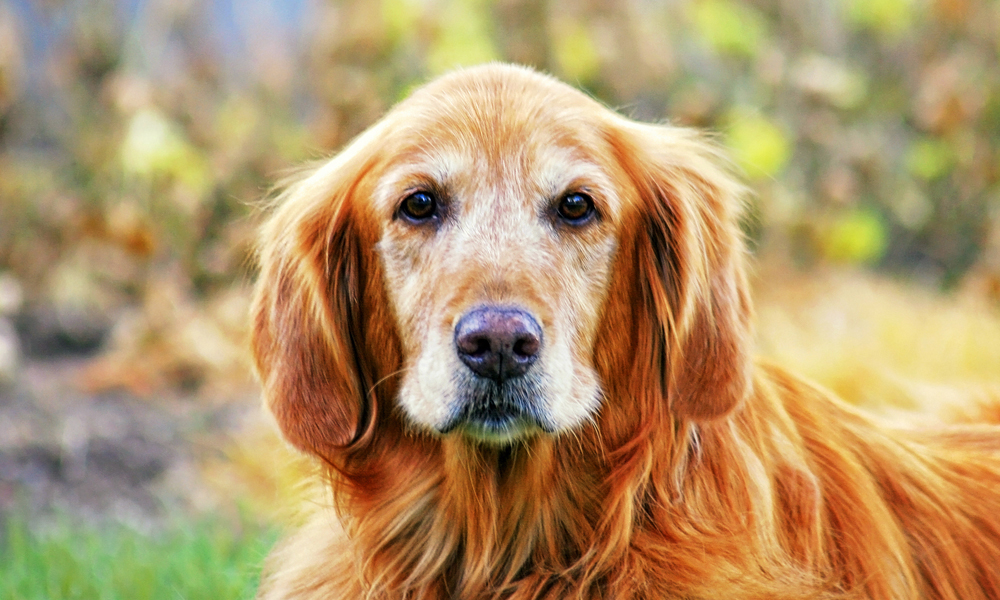Feeding your dog the right diet is critical at all life stages. What’s key for dogs at any age is providing the variety and range of nutrients for their bodies to live their best, fullest lives. That means when your canine friend hits their senior stride, you’ll want to provide the diet that meets their unique nutritional needs that keeps their bodies in top condition.
So when is a dog considered a senior? Small dogs are considered senior citizens when they reach 11-12 years of age, while it’s more at the 10-year-old point for medium-sized dogs. In larger breeds, signs of old age can start showing up at age 8. Finally, giant breeds are usually considered seniors at age 7.
5 common health problems of senior dogs
As your dog’s age creeps upward, you might notice graying in the muzzle along with changes in their activity level. Many parents find this less-hectic pace an enjoyable stage in their pet’s life — perhaps it’s accompanied by less reactivity and better discernment as the canine rocks their fully mature personalities. Still, this is a time to be aware of the common issues that senior dogs have and how their diets can support them — and even alleviate certain issues.
1. Obesity
Aging dogs aren’t on the move as the younger pups are. The zoomies may be a thing of the past! A less active dog means they’re burning fewer calories, which means you’ll want to adjust mealtimes accordingly. Otherwise, as the extra pounds creep in, it can set your dog up for cascading health issues — such as increased pain in the joints and ligaments, high blood pressure, heart disease, diabetes and renal failure.
To support your dog’s health, make sure they get enough activity and movement in their day. For healthy eating, start adjusting the portion sizes as soon as your older dogs start scaling back on the activity level. A senior diet with lower fat and protein macros will keep the calorie count down, while the higher levels of fiber help them stay satiated longer.
2. Arthritis
Stiff swollen joints are another age-related ailment in senior dogs. Causes can come from wear and tear of the cartilage that cushions their joints — which is why working dogs and active breeds can be susceptible to developing pain in their elder years. Senior dogs can also develop hip dysplasia, a painful and degenerative bone disease that often manifests later in a dog’s life.
To support your dog, recognize the early signs of joint pain, such as refusal or hesitation to perform routine activities — like standing, laying down and using the stairs. Consider accommodations to reduce joint stress, such as a ramp for your arthritic dog so they can join you on the couch or use the stairs to the backyard.
Again, a senior diet that helps with weight management prevents extra pressure on the joints. A diet that promotes joint health can also help. Look for omega-3 fatty acids, along with probiotics that provide gut health support, which are linked to lower levels of inflammation.
3. Liver disease
Liver diseases such as hepatitis and cirrhosis of the liver in dogs can occur at any life stage but become increasingly common as dogs become older. Cirrhosis of the liver can be deadly because it’s a process where scar tissue replaces normal, healthy liver tissue, thus impeding the organ’s ability to function and remove toxins from the body.
Tell-tale signs of liver problems in senior dogs include jaundice (yellow in the gums and the white of the eyes), along with a swollen abdomen that’s painful to the touch accompanied by a loss of appetite and a drop in energy levels.
To maintain health in senior dogs, focus on good nutrition with probiotics to help your dog’s body ward off viral and bacterial infections.
4. Cognitive decline
Just like humans, old age in canines can be accompanied by a decline in memory and cognitive abilities. Cognitive dysfunction syndrome is a canine brain deterioration occurring in more than a third of dogs ages 9 and older. Common signs include restlessness, wandering and pacing, as well as irritability and aggression.
Keeping your senior dog’s mind sharp and engaged will help with healthy brain function in their later years, so provide plenty of engagement and enrichment. Look for senior dog food diets that include selenium yeast to neutralize free radicals in the bloodstream. These contain antioxidants that are linked to preventing age-related cognitive decline.
5. Bad breath
Foul breath in older dogs is commonly linked to dental issues. Dental disease can escalate as dogs age, which means they’re susceptible to gingivitis, tooth decay and gum disease, any of which can make canine breath smell rotten.
However, foul breath in older dogs can be symptomatic of other health issues, ranging from ingredient sensitivities to kidney disease. At the onset of changes in your dog’s breath, you’ll want to schedule a vet visit to confirm the root cause.
Preventing bad breath in senior dogs comes down to preventive dental care, including tooth brushing and annual professional cleanings. And you’ll also want to keep their gastrointestinal tract in balance with a diet that provides probiotic nutrients.
When to switch your dog to senior food
When is it time to switch your dog to senior food? This decision hinges on the breed of your dog, along with the overall health and energy level of your canine friend. But the good news is that switching to senior dog food is more straightforward. Because unlike switching your dog from puppy food to adult food, timing isn’t an issue.
This is a decision you can make with the guidance of your pet’s veterinarian. Many owners switch to senior diets when their canine friend reaches middle age, typically at age 7, around the time they see a downshift in their dog’s activity levels.
The bottom line, as you begin to see changes in your dog’s habits and behaviors related to older age, it may be time to switch to a senior dog diet.
Weight management for senior dogs: Considerations by size
Senior dogs don’t have the energy they used to. Because they’ll be spending less time romping in the yard, senior dogs, both large breeds and small breeds, require fewer calories than younger dogs.
Large and medium breeds
Weight management for large-breed and medium-breed senior dogs is critical because these larger breeds are more likely to develop hip dysplasia. Keeping their calories under control to prevent weight gain is key to managing the condition if it develops in your pet and keeping them comfortable and happy.
Small breeds
Dog food for senior small breeds should similarly focus on weight control. In fact, it can be a larger challenge for these pet parents because the bodies of smaller breeds are less forgiving to weight gain. Even a pound or two of excess weight can push them into obese levels, straining joints and ligaments, and aggravating their arthritis.
How to portion senior dog food for weight management
If portion sizing wasn’t a concern with your dog in the past, because their bodies used every bit of fuel, your dog is now in a life stage where it may become a problem.
First, confirm your dog’s weight, because dog food is portioned by their size. Then find your dog’s weight range on the bag of dog kibble and portion accordingly. (Pro tip: For perfect portions at every mealtime, use a food scale and an empty plastic food container to measure out the right portion. Then cut down the container to create the right-sized “scoop” for your pet.)
Get moving!
The final consideration for weight management in your dog’s senior years is not allowing exercise to fall by the wayside. Set timer reminders for daily walks and play sessions.
Stomach sensitivity in senior dogs
As a dog ages, so does their stomach. It’s common for senior dogs to develop signs of a sensitive stomach, including vomiting and diarrhea.
Changes in the small intestine
One culprit can be linked to the small intestine’s decreased ability to absorb nutrients, which gradually declines in the aging process. That means this tends to be a more serious issue with geriatric dogs than canines that are just entering their senior years.
As their food goes to “waste,” their body misses out on the carbs, amino acids, fats and vitamins they need to stay healthy. Eventually, instead of having to worry about weight gain in senior dogs, pet parents become concerned about excessive weight loss. That’s where stomach sensitivity in senior dogs leads to compounding health issues because they’re not getting the support they rely on from their food.
Gastroenteritis
Gastroenteritis is irritation in the gut with many causes, which your dog can be more susceptible to in their older age. These causes include food allergies, parasites, and viral or bacterial infection. In the most severe and deadly cases, the causes can be an intestinal blockage and organ failure.
What can you feed your dog when they have these ailments?
Dog food with high bioavailability: The best dry dog food for senior dogs? Look for a brand that’s rated high in bioavailability — fortified with amino acids to help their bodies access the building blocks of protein and probiotics to help the body break down the food for maximum absorption.
Wet food: If your senior dog is losing weight or being pickier than normal, add protein by offering a canned senior formula. As an added benefit, your dog will find the aroma of wet food enticing — and will be more likely to eat!
Probiotics for gut health: A diet that’s rich in probiotics builds a colony of good bacteria in the gut, creating the conditions for rapid improvement in your pet’s digestive process.
FAQs about feeding your senior dog
Still have questions? Here are some answers to the most frequently asked questions about how to feed your senior dog.
Q. Can a senior dog eat puppy food?
A. When you’re in a pinch, there’s no harm in feeding your senior dog puppy food, as long it’s temporary. Because puppy food is high in calories to meet the high-energy needs of growing bodies, the important thing to remember is not to overdo it. Watch the portions, and as soon as you can, return your senior dog to its regular diet.
Q. How to transition a dog to senior food
Simple answer: it depends on the brand. If you’re switching between brands or introducing a new protein, it’s always wise to start by integrating a small amount of the new food with the older diet, gradually increasing the ratio each day. This helps you see how their body responds to the new food while also helping pickier dogs get used to something new and different.
However, if you are switching to the NutriSource Senior Pet diet, you can speed up or even skip the gradual method. As long as your dog is enjoying the food, you can make the full switch quickly.
Q. What’s the difference between adult and senior dog food?
A. What sets senior dog food apart from adult/puppy diets is these are diets to meet the needs of older dogs, with fewer calories, less fat and protein, but higher in fiber.
Optimized nutrition for your senior dog
A healthy gut is a healthy mutt, particularly when your dog reaches their senior years! Good 4 Life has the probiotics and nutritional enhancements to support gut health, which helps your dog’s body fight inflammation and defeat pathogens. Shop local and look for NutriSource Senior Recipe at a local independent pet retailer.


